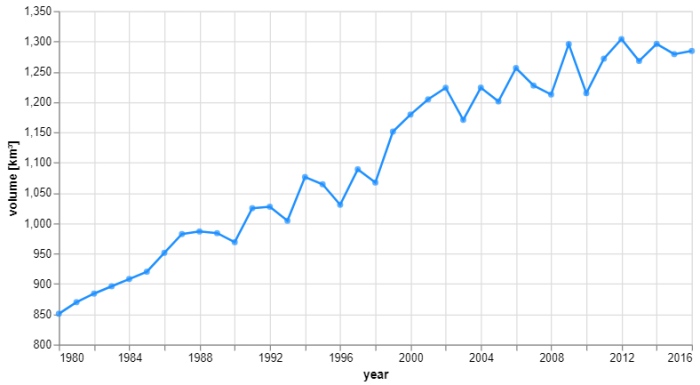
The current climate crisis reminds us, every day, how vital it is to manage sustainably the consumption of energy and resources in favour of savings. Although it may be a subject that can raise awareness more or less all, that of climate change is such a vast and complex subject that it often falls into the banal repetition of the importance of safeguarding our planet without being aware of how, quantitatively, our life experiences affect the health of the world in which we live. We are used to hearing about “extreme climatic events caused by man”, but our perception, sometimes ideological of them, how far away from what we observe daily through the waves of drought and heat or with the storms of wind and storms? Defendit numerus, that is “in numbers is security” and the Human Impacts Database could help us in the rationalization and understanding of what is happening to the planet.
What is meant by Human Impacts Database and how it is born
Human Impacts Database means a database that can quickly and reliably quantify the influence of human actions on the planet through 5 main categories: water, energy, flora and fauna, atmospheric and biogeochemical cycles and land, They can also be divided into another 20 subcategories, including agriculture and deforestation. To access the site you need to type http:///www.anthroponumbers.org/catalog/ and the resulting web screen will offer two modes of operation: if you need to carry out a specific search it will be enough to write a keyword or you can simply click on one of the categories or subcategories available on the page. Entering the first category, “Water”, we will be faced with a list of: quantity – value – HuID (acronym of the database) – source and selecting, by way of example, the item “Global water volume used for irrigation” you can consult different data, among which the graph of the trend in the volume of water used for irrigation in the period 1980-2016: it is directly observed that this has undergone a sharp increase over time.
Each item is then associated with a quantitative value or, when available, with a series of numerical values referring to a precisely determined time frame, in order to analyse the changes that have occurred over the years. Each parameter is linked not only to the primary source but also to the measurement and/or estimation methods, to the different links and to the permanent identifier in question, namely the Human Impacts Database (HuID). The information contained is really many, in fact, as the initial screen suggests it is “a collection of 307 numbers useful to quantify the impacts of human presence on Earth” and range from the pre-industrial atmospheric CO2 concentration to the production yield of cow’s milk: extraordinary!
In many cases, graphs and photographs help to illustrate in a more intuitive way the numerical elements presented by the database. Concretely, anyone can thus have additional notions about everything related to human activity and how it irremediably affects the health of the Earth.
The project has a global rather than local footprint and, through the use of scientific papers, government and intergovernmental reports, it is imperative to determine how these general data align with each other significantly. In the presence of numerous sources, scientists report more than one value per number in order to obtain a considerable certainty of the same, thus increasing its significance.
The portal was designed by a group of scientists from California at the University of Stanford; at the head of the team there are Rob Phillips, Fred and Nancy Morris, teachers of Biophysics, Biology and Physics together with Griffin Chure and Rachel Banks (PhD students).
“For example, a friend wrote to me asking me how to compare the impact of dairy cattle with meat cattle.” “We can use our database to understand that, in terms of land requirements, greenhouse gas emissions and water use, beef cattle have an impact greater than a factor of five or more per calorie. We really hope that this database will be useful both for ordinary citizens who try to make decisions and for those who think about politics. I consider being literate with numbers as a prerequisite for being informed, whether you are a citizen or a scientist”.

Purpose of the database
The team points out that the database is not complete or exhaustive and that it is planned to continuously update the numbers for the different categories examined. The purpose of the portal is to guarantee to all, citizens and scientists, the acquisition of simple numbers on human impacts so that it can effectively develop a realistic idea of how each individual activity has repercussions on the world and the environment; The ultimate goal is to make everyone aware of how our choices can be practically decisive.
“In my opinion, the root of understanding is mathematics: once you have numbers, it becomes clear what the problems are, what the significant things are, and what the less.”, says Phillips. “Charles Darwin once remarked that calculus gives a ‘sixth sense’. The Human Impacts Database is a first step towards providing a coherent invitation to that sixth sense in the context of the great human experiment.”, adds the Californian professor.
“Supporting the development of this tool, along with other incredible research that the Resnick Sustainability Institute supports on campus, is key to fulfilling our mission of educating and informing people about their impact on the world, as well as providing solutions to the problems that these impacts are causing,” says Neil Fromer, Executive Director of Programs at the Resnick Sustainability Institute in Caltech (RSI), which partly contributed to the funding of the project.
In this last quotation you can enclose the narrow sense of the indicator Human Impacts Database.



































